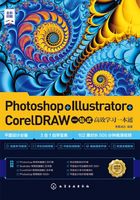
2.5 路径的编辑
除了使用“路径选择工具” 、“直接选择工具”
、“直接选择工具” 对路径进行调整外,还可以复制/删除路径、存储路径,描边路径和填充路径等。下面对其相关知识进行详细介绍。
对路径进行调整外,还可以复制/删除路径、存储路径,描边路径和填充路径等。下面对其相关知识进行详细介绍。
2.5.1 选择路径
在对路径进行编辑操作之前首先需要选择路径。在工具箱中选择“路径选择工具” ,将光标移动到图像窗口中单击路径,即可选择该路径,如图2-79所示。选择路径后按住鼠标左键不放进行拖动即可改变所选择路径的位置,如图2-80所示。“路径选择工具”
,将光标移动到图像窗口中单击路径,即可选择该路径,如图2-79所示。选择路径后按住鼠标左键不放进行拖动即可改变所选择路径的位置,如图2-80所示。“路径选择工具” 用于选择和移动整个路径。
用于选择和移动整个路径。

图2-79

图2-80
“直接选择工具” 用于移动路径的部分锚点或线段,或者调整路径的方向点和方向线,而其他未选中的锚点或线段则不被改变,如图2-81、图2-82所示。选中的锚点显示为实心方形,未被选中的显示为空心方形。
用于移动路径的部分锚点或线段,或者调整路径的方向点和方向线,而其他未选中的锚点或线段则不被改变,如图2-81、图2-82所示。选中的锚点显示为实心方形,未被选中的显示为空心方形。

图2-81

图2-82
操作提示
按住Shift键,可以选择其他锚点。
2.5.2 复制和删除路径
选择需要复制的路径,按住Alt键,此时光标变为 形状,如图2-83所示,拖动路径即可复制出新的路径,如图2-84所示。
形状,如图2-83所示,拖动路径即可复制出新的路径,如图2-84所示。

图2-83

图2-84
操作提示
按住Alt键的同时按住Shift键并拖动路径,能让复制出的路径与原路径成水平、垂直或45°效果。
删除路径非常简单,若要删除整个路径,在“路径面板”中单击选中该路径,单击该面板底端的“删除当前路径”按钮即可。若要删除一个路径的某段路径,使用“直接选择工具”选择所要删除的路径段,按Delete键即可。
2.5.3 存储路径
在图像中首次绘制路径会默认为工作路径,若将工作路径转换为选区并填充选区后,再次绘制路径则会自动覆盖前面绘制的路径,只有将其存储为路径,才能对路径进行保存。
在“路径”面板中单击右上角的 按钮,在弹出的菜单中选择“存储路径”命令,弹出“存储路径”对话框,在该对话框的“名称”文本框中设置路径名称,单击“确定”按钮即可保存路径。此时在“路径”面板中可以看到,“工作路径”变为了“路径1”,如图2-85、图2-86所示。
按钮,在弹出的菜单中选择“存储路径”命令,弹出“存储路径”对话框,在该对话框的“名称”文本框中设置路径名称,单击“确定”按钮即可保存路径。此时在“路径”面板中可以看到,“工作路径”变为了“路径1”,如图2-85、图2-86所示。

图2-85

图2-86
操作提示
将工作路径拖动到“路径面板”底部的“创建新路径”按钮上松开鼠标也可以存储路径。
2.5.4 描边路径和填充路径
描边就是在边缘加上边框,描边路径则是沿已有的路径为路径边缘添加画笔线条效果,画笔的笔触和颜色用户可以自定义,可使用的工具包括画笔、铅笔、橡皮擦和图章工具等。
具体的操作方法是设置好前景色,选择用于描边的工具(画笔工具,笔触大小为2像素),在“路径面板”中选中要描边的路径,单击面板底端的“用画笔描边路径”按钮即可,如图2-87、图2-88所示。

图2-87

图2-88
操作提示
按住Alt键的同时单击用画笔描边路径按钮,将打开描边路径对话框,在该对话框中可以选择描边使用的工具。
填充路径能对路径填充前景色、背景色或其他颜色,同时还能快速为图像填充图案。若路径为线条,则会按“路径”面板中显示的选区范围进行填充。
操作方法:设置好前景色后,在“路径面板”中选中要描边的路径,单击面板右上角的菜单按钮,在弹出的快捷菜单中选择“填充路径”命令,打开的“填充路径”对话框,从中设置填充的方式,如图2-89所示。单击“确定”按钮即可,如图2-90所示。

图2-89

图2-90
课堂练习 制作路径文字
本案例主要利用了描边路径的命令制作文字,下面将对其进行具体的讲解。

扫一扫 看视频
Step01 启动Photoshop应用程序,执行“文件>打开”命令,打开本章素材“灯光背景.jpg”,如图2-91所示。

图2-91
Step02 选择“文字工具”输入文字,设置文字的字体、字号,如图2-92所示。

图2-92
Step03 按住Ctrl键的同时单击“图层”面板中的缩览图,建立选区,如图2-93、图2-94所示。

图2-93

图2-94
Step04 单击“路径”面板底端的“从选区生成工作路径”按钮,将选区转化为路径,如图2-95所示。

图2-95
Step05 单击工具箱中的“设置前景色”按钮,弹出“拾色器”对话框,在对话框中选择前景色,单击“确定”按钮,应用颜色,如图2-96所示。

图2-96
Step06 单击“图层”面板底端“创建新图层”按钮,新建图层,如图2-97所示。

图2-97
Step07 在工具箱中选择“画笔工具”,执行“窗口>画笔设置”命令,弹出“画笔设置”面板,在面板中设置“画笔笔尖形状”及“形状动态”,如图2-98、图2-99所示。

图2-98

图2-99
Step08 选择新创建的图层,在“路径”面板中选择工作路径,右击鼠标,在弹出的菜单栏中执行“描边路径”命令,如图2-100所示。

图2-100
Step09 弹出“描边路径”对话框,在工具下拉列表中选择“画笔”,单击“确定”按钮,应用画笔描边,如图2-101所示。

图2-101
Step10 隐藏路径,如图2-102所示。在“图层”面板中单击文字图层“指示图层可见性”,将文字图层隐藏,如图2-103所示。

图2-102

图2-103
Step11 按Ctrl+J组合键多次复制“图层1”,加强光线,并将新建的图层和拷贝的图层选中,并按Ctrl+E组合键,将图层合并,如图2-104所示。

图2-104
Step12 最终效果如图2-105所示。

图2-105
至此,完成路径文字的制作。